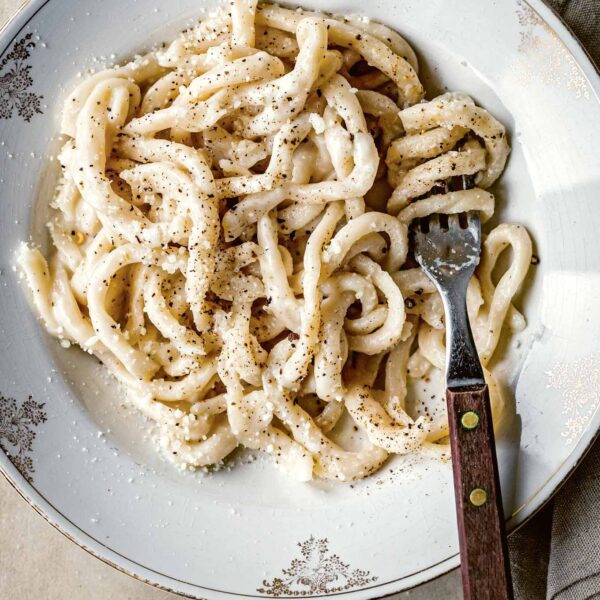
Pici Cacio e Pepe: Hand-Pulled Pici Pasta with Cheese and Black Pepper
Ingredients
For the Pici
- 3¼ cups 400 g all-purpose flour
- ¾ cup plus 2 Tablespoons/200 ml water
- 1 tablespoon extra-virgin olive oil
- 1 teaspoon fine sea salt
- 3 tablespoons semolina flour, plus more for dusting
- ¼ cup 35 g cornmeal
- extra-virgin olive oil for brushing
For the Sauce
- 2 teaspoons whole black peppercorns, or more to taste
- 5 oz 140 g Pecorino Romano, grated
Instructions
- Make the pici: Pour the flour onto a work surface and shape into a mound with a large well in the center. Add the water, olive oil, and salt to the well and, using a fork, stir slowly to incorporate the water and oil, starting from the center and gradually picking up more flour from the edges. When the dough turns crumbly, switch to kneading with your hands. You want to knead the dough until it forms a ball, the gluten starts to develop, and the dough feels elastic. Continue kneading until you have clean hands and a clean board and the dough is smooth, silky, matte white, and no longer sticky, about 15 minutes. It should spring back when pressed. If it is too stiff, add water a few drops at a time and knead it in.
- Alternatively, you can make the dough in a stand mixer fitted with the dough hook. Knead for about 5 minutes on low speed, then turn it out and finish kneading by hand for about 5 minutes.
- Cover the dough with an upturned bowl and let rest for 30 minutes.
- In a medium bowl, stir together the semolina and cornmeal. Dust a rimmed baking sheet with semolina flour and set nearby.
- On a clean work surface, with a rolling pin, roll out the dough into a ¼-inch-thick/6 mm round. Brush the dough with olive oil to keep it from drying out while you make the pici. Using a pizza cutter or a very sharp knife, cut the dough into strips about ¼ inch/6 mm wide. With one hand, hold each strip down on one end and, using the other hand, roll and pull the strip into the pici shape (like thick, chubby spaghetti), drop the pici into the semolina-cornmeal mix, and then coil the noodle around your hand and place on the prepared baking sheet. Repeat with the remaining dough.
- Make the cacio e pepe: In a small frying pan, toast the peppercorns over medium heat for a few minutes, until you start smelling their pungent aroma. Transfer the peppercorns to a mortar and pound with the pestle until finely ground.
- Transfer the pepper to a large bowl and stir in the pecorino.
- Bring a large pot of water to a rolling boil and salt it lightly. Add the pici and cook for 5 to 6 minutes, until just al dente. Pici have a dense, chewy texture; do not overcook them. Just before the pici are done, scoop out ½ cup/120 ml of the pasta water, add it to the bowl with the pecorino and pepper, and stir with a wooden spoon to form a thick paste.
- Scoop out another ½ cup/120 ml of the pasta water, then drain the pici, transfer them to the bowl, and toss energetically with the sauce, adding some of the reserved cooking water if needed and tossing to perfectly emulsify the sauce, until it thoroughly coats the pici. Serve immediately, as the cheese tends to cool and set quickly.
Notes
Fresh pici should be cooked as soon as they are made, but if you want to prepare them in advance, you can freeze them. Spread the pici on a large rimmed baking sheet dusted with semolina flour and freeze until firm, then transfer to a zip-top freezer bag and freeze for up to 3 months. Pop the pici into the boiling water still frozen, and allow a couple of minutes more to cook them.